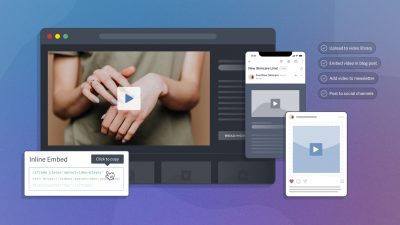Keeping up with the pace of change in the modern world can feel overwhelming. After a long day, it requires a lot of discipline to pick up a book or go to a talk. Even reading an article can inspire pangs of guilt when to-do’s are piling up on your desk.
This is exactly where video learning centers come in. When done well, video learning centers can fit a variety of learning styles, overcome information fatigue, and improve the efficiency of information communication to boot.
Read on for ten best practices for building, growing, and evaluating the impact of a video learning center.
What is a Video Learning Center?
Images of stuffy libraries may come to mind, but today’s video learning centers are anything but. Accessed online, educational video portals exist to train and inform audiences about specific tasks, concepts, or processes.
These portals can have a variety of uses depending on their intended audience. Here are just some of the ways you could leverage a video learning center for your organization:
- Educate your customers about product features, or ways of using your products
- Onboard new employees
- Retrain existing staff
- Community outreach for specific initiatives
- FAQs for a website
- How-to videos on a given topic or process
- Additional resources for students
Why You Need One
Video, the most engaging content format, can cure information fatigue by presenting it in an energizing and compelling format. Even better, it’s been shown to improve retention, and transmits information more efficiently than other mediums.
1. Topic Selection
To be successful, your collection of videos needs to have an overarching theme. What is the ultimate goal of creating this video portal?
You can be as general or granular as you’d like. For example, “Improve employee on-boarding,” or “Provide customers with better resources to drive utilization of our services” would be excellent goals to aim for.
The purpose of setting a larger goal is to avoid getting too far into the weeds when it comes to individual video topics. Align the rest of your content with this larger goal, and you’ll end up with a cohesive collection of content.
Picking Individual Video Topics
For individual video topics, look to the audience you are seeking to address for inspiration. What are their common questions? Where do they get stuck? What do they need to know in order to take certain actions?
You can cull this information from a variety of sources:
- Talk to your sales team, or customer support staff, for insights into clients and users.
- Look for trends in visitor behavior on your website with a tool like FullStory, or look to your design team for insights.
- Survey managers to pinpoint resources needed by existing staff.
- Ask recent hires what they wish they had known when they started.
- Analyze exams or recent homework to understand where students need extra support.
- Check website traffic to see which help articles or blog posts are the most popularly sought out.
Doing research upfront will ensure you’re providing content people really need. This process should result in a list of needs that can be addressed with specific videos.
2. Production Value
Whether these videos are internal, or publicly facing, the production quality counts for a lot. That doesn’t mean you can’t DIY these videos. It just means you can’t skip the basics when it comes to filming or editing.
Educational videos can take a variety of forms. Many feature talking heads, screencasts, news clips, stock footage or images, and text overlays. Each component needs to look and sound good, or it can negatively impact the finished product.
To achieve a polished result with video, pay close attention to the quality of the inputs you’re using. Here are some high-level basics you should keep in mind:
- Make sure your shots are framed correctly, and are filmed in HD.
- Use appropriate audio equipment to capture clear dialogue.
- Take precautions to prevent unwanted background noises.
- Check your lighting to avoid glares or harsh shadows.
- Make sure stock footage or images are HD quality and the same aspect ratio as your video.
- Check licensing for any music or media used in the video (yes, even for internal videos).
Well-made videos will help engage viewers and keep them watching.
3. Short and Sweet
It’s tempting to run through an entire process end-to-end in one massive two hour long video. We’re here to tell you that’s not very viewer-friendly.
An effective educational video resource contains clips of discreet information that can be assembled into a greater whole. One viewer might need to know just one specific thing, and will skip to that section. Another viewer might need to cover the basics before advancing that far ahead.
Design your content to accommodate different learning styles and a range of needs. Each subsection of a topic could be a standalone video, for instance.
By restricting the scope of each video, it will be easier to remain concise. In turn, this enables viewers to quickly get answers to their questions, or to explore related videos as needed.
4. Organization
There are several different ways you could potentially organize your video library. The natural choice is by topic, although there could be better ways depending on your aims.
For instance, think about who might need to access each resource. It might make sense to organize your video learning center by persona, instead of just by subject matter.
Beginners should likely start with a different series of videos than experts, for example. Within each track, you could then organize videos alphabetically, by topic, or in a sequential manner that fits a specific process.
This type of hierarchical organization will help viewers find the materials they need easily. It will also ensure the content is presented in an order that helps viewers build on their knowledge as they explore your learning center.
If you’re using one of our video websites as your learning center, you can take advantage of tags and categories to organize your videos.
5. Mobile Matters
When designing your content and your video learning center, consider the fact that many of your viewers will be on mobile devices, if not the majority.
Ensuring your videos are mobile-friendly will drive engagement and video completion rates. It’ll also provide added convenience for your viewers since they’ll have a great experience no matter when or how they access your videos.
Mobile-friendly video content loads quickly, plays smoothly, and adjusts to the size of the screen correctly. SproutVideo takes care of all of those factors for you automatically when you’re using our video websites. If you’re embedding your videos, we also offer responsive video embed codes to ensure your videos resize correctly according to the screen on which they’re played.
Beyond that, you might add some additional tools to help viewers absorb the information. For instance, you can add subtitles, or animated text overlays, to ensure those listening with the video muted can still understand it. Make sure the text, and any graphics used, won’t be too small to comprehend on a phone screen.
6. Access Permissions
Is your video learning center a public resource for all to share? Or is it intended only for very select audiences?
If it’s public, you don’t need to worry about who might be accessing your content. If it’s not, then video security needs to be a priority.
Depending on how you share your videos, you have several options to keep your educational videos secure:
Embedding:
- If you are embedding your videos on a company website, place them within a secure section of the website.
- Then, leave your videos set to Private on the SproutVideo platform. Private videos only appear and are playable where they are embedded.
- If you require additional security, you can use allowed domains to ensure your video embed codes will only work on the website(s) you specify.
Sharing on SproutVideo Landing Pages or Websites:
- Use Password Protection, Login Protection, SSO, or IP Address restriction. Refer to this overview of different video privacy settings for more details on those different settings.
7. Up-To-Date
There’s nothing worse than spending time studying up on something, only to discover the material you covered was inaccurate or out-of-date. Make sure that never happens to your viewers by performing periodic content reviews, and updating anything that isn’t quite right.
The best time to perform content reviews is during major updates to your products, services, branding, or company policies. That way you can get ahead of any necessary changes.
You’ll also want to be sure your content reflects the latest and greatest information about a topic. Set Google Alerts to notify you whenever new publications are released about any topics or brand names pertinent to your video learning center. That way you can prioritize updates as they come in.
If none of the above seems to apply to your specific niche, you should still try to review your content on a regular basis. Whether it’s monthly, quarterly, or annually, your viewers will thank you.
8. Supplemental Info
Sometimes, a video might not be enough. The surrounding content on a page can help viewers put each video in context. It can also help them navigate to related topics of interest.
Add links, images, PDFs, or text that adds to the learning experience of the viewer. Consider including key definitions, short biographies of any persons mentioned in the video, or written guidance on complex procedures.
This information can be placed anywhere on the page on which the video is embedded. Generally speaking, you’ll want to keep the video above the fold since it’s likely the focal point of that page.
On SproutVideo websites or landing pages, you can use the video description field. Add text or links to related info, and it will appear below the video. Description fields support basic HTML formatting to help keep this information organized.
9. Goal Setting
You’ve got your videos up, and viewers are clicking play, but how do you know if they’re learning anything?
You can always quiz viewers about what they learned, and whether or not the videos were helpful. But, that doesn’t always work. You might not get the response rates you were looking for, or respondents might not recall everything perfectly.
Instead, use different metrics to analyze the performance of your videos. This can tell you a lot about whether or not you are reaching viewers, and which videos in particular are doing well.
Play Rate
For starters, look at your play rate for different videos. This metric helps you determine whether or not viewers are electing to watch the video after the page loads. It allows you to compare performance across different videos better than by just looking at plays alone by controlling for the popularity of the subject.
A high play rate would be a good indication that the video is relevant to people arriving on the page; the poster frame image was compelling; and that the video is interesting to viewers.
On the flip side, a low play rate would indicate viewers aren’t very interested in watching a given video. To encourage more people to watch the video, try changing up the content on the page describing the video, swap out the poster frame, or try a different approach on the same topic entirely.
Engagement Rate
Ever want to know whether someone actually watched your whole video, or simply clicked play? You can, with Video Engagement Metrics.
This reporting uses heatmaps with different colors to indicate the number of times a specific viewer watched different sections of your videos. You can tell at a glance whether someone watched, rewatched, or skipped segments of a video.
The best metric to track is the engagement rate, also known as the completion rate. Ideally, viewers will watch at least 100% of a video, meaning they watched the whole thing.
A video with a low completion rate would indicate that viewers lost interest over the course of the video. Either the script was dull or repetitive, the topic was boring or not what they expected, or a specific section of the video is off-putting for some other reason.
By diving into this stat, you can drive future content development by noting which videos have the highest or lowest engagement rate. Topics that drive high engagement from viewers are likely to be very relevant to their interests, indicating more content might be needed.
Lower engagement rates might be associated with videos that are too basic or simple to be worth watching. It probably isn’t in your best interests to keep creating videos on these subjects.
10. Improve Your Videos Over Time
Truth be told, you’re never exactly done building a great video learning center. They evolve and grow over time, along with best practices and technology.
As mentioned above, Video Engagement Metrics allow you to understand how viewers are engaging with your content. This data can also help you improve your videos.
For example, you might notice that viewers tend to rewatch or skip a specific part of a video repeatedly. Revisit that video to edit for clarity, and check the quality of the visuals and audio. There might be a simpler or better way to present the information.
Have you built a video learning center? Wondering how to get started? We’re here to help.








